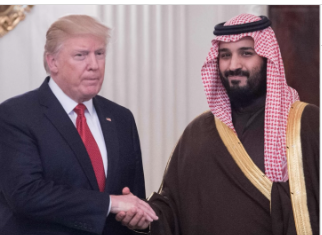Saudi Arabia’s promise to invest $600 billion in the American economy has generated a wide range of responses in recent days, from cautious optimism to strategic applause. The commitment, which was made public during President Donald Trump’s deal-driven trip to Riyadh, consists of an incredibly successful combination of space cooperation, tech investments, and defense agreements. Fundamentally, this is more than just a capital inflow; it is an indication that Washington and Riyadh’s economic ties are about to enter a completely new stage.
The announcement’s centerpiece is an arms deal worth almost $142 billion, the biggest of its kind in American history. However, diversification is the real story, not missiles and jets. The Saudis are employing a particularly creative approach by investing in vital industries, such as mining and space, which combines short-term geopolitical influence with long-term ambition.
Saudi Arabia Investment in the U.S. – 2025 Overview
| Attribute | Details |
|---|---|
| Total Saudi Investment Commitment | $600 billion (announced 2025) |
| Focus Areas | Energy, Defense, Mining, Real Estate, Automotive, AI, Aerospace |
| Largest Arms Deal Value | Nearly $142 billion |
| Total U.S.-Saudi Trade (2024) | $25.9 billion |
| U.S. Exports to Saudi Arabia | $13.2 billion |
| Saudi Imports to U.S. | $12.7 billion |
| Direct Saudi Investment (2023) | $9.5 billion |
| Space Collaboration | CubeSat on NASA’s Artemis II launch |
| Major Stakeholders | Mohammed bin Salman, Donald Trump, Yasir Al-Rumayyan, Elon Musk |
| Reference Source | www.trade.gov |
AI for Equity vs. Oil for Security
Saudi Arabia is changing the story of bilateral relations by working with American institutions, private companies, and agencies. These investments show a conscious shift away from reliance on oil and toward science, technology, and sustainability within the framework of Vision 2030, Crown Prince Mohammed bin Salman’s plan for economic reform. A daring dedication to space diplomacy is demonstrated by the kingdom’s collaboration with NASA, which includes the installation of a Saudi CubeSat aboard Artemis II.
This multi-sectoral strategy is very adaptable. It enables Saudi Arabia to import infrastructure and expertise necessary for its own transition while also financing innovation based in the United States. Riyadh is creating a feedback loop that is both strategically balanced and economically advantageous by fusing its capital with American innovation.
Overdrive Economic Diplomacy
Trump’s comments at the Riyadh investment forum were humorous—”Oh what I do for the crown prince”—but the agreements he signed were extremely serious. The agreements are intended to be extremely effective tools for both parties’ economic development, from co-developing energy infrastructure to mining rare minerals. The modernization of the U.S.-Saudi Air Transport Agreement, for instance, has greatly improved cargo logistics between the two countries and third countries, boosting international trade routes.
The level of alignment is what distinguishes these collaborations from earlier ones. These gestures aren’t symbolic. These are sensible choices supported by executive authority, sovereign wealth, and business necessity. Additionally, they arrive at a time when efforts are underway to reorganize global supply chains so that resilience takes precedence over convenience.
The Shadow of Khashoggi and a Novel Story
Although the 2018 murder of journalist Jamal Khashoggi caused a great deal of tension between the United States and Saudi Arabia, Trump’s current stance—eschewing controversy in favor of business—reflects a conscious reset. It may be controversial to call bin Salman “an incredible man,” but Saudi Arabia wants to change the world’s attention from the past to the present.
The Saudi leadership is enhancing its reputation as a reform-minded power broker ready to interact with the most aspirational minds in technology and finance by welcoming business titans like Elon Musk, Sam Altman, and Larry Fink. These high-profile exchanges foster trust and establish Saudi Arabia as a creative partner in addition to a source of capital.
Changing the Strategic Partnerships Map
The purpose of this Saudi investment wave is strikingly obvious in light of the global decoupling and changing alliances. It’s about using shared innovation to increase diplomatic flexibility while using capital to anchor influence. Though essentially more cooperative, it is remarkably similar to what China tried with the Belt and Road Initiative.
For its part, the United States gains access to one of the world’s deepest sovereign funds and a trustworthy partner for joint ventures that go well beyond oil. Saudi-backed American businesses could lead the way in AI, energy storage, and even quantum computing in the years to come. These sectors influence civilizations rather than merely shifting markets.
Purpose-Oriented Wealth
The United States and Saudi Arabia are creating a new economic partnership through strategic partnerships, simplified legal frameworks, and a mutual desire for investments with an eye toward the future. It’s a blueprint for what cross-border cooperation might look like in a digital, decarbonized future, not a throwback to the past.
The Saudi commitment may be especially helpful for supply chain architects, infrastructure developers, and early-stage tech startups. It provides liquidity access, entry into the Gulf market, and international validation of their business strategies. Additionally, Saudi Arabia is getting closer to lowering its reliance on a resource that no longer determines its future with each dollar spent on American soil.


